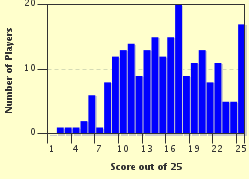Quiz Answer Key and Fun Facts
1. If I have an expression for an object's position, what can I also determine about the object, calling it a?
2. In the linear equation y = mx + b, what value does b correspond to?
3. As seen in Einstein's mass-energy equivalence, E = mc^2, c is the speed of light in a vacuum. What is the exact value of c?
4. A journey through the center of the Earth and out the other side would traverse what d distance?
5. Named after Leonhard Euler, the number e is one of the one of the most important numbers in all of mathematics. What is its approximate value?
6. The letter F can be used to represent a factorial number.
7. What uniquely tellurian constant, approximately equal to 9.81 meters per second per second, is also known as g?
8. Both h and the related h-with-a-small-dash are related to the energy of a photon, and were discovered by which physicist in 1900?
9. It may look complex, but i is a very important number in mathematics. What is i also known as?
10. Along with i, j and k are commonly used to represent the components of what type of number?
11. What measure of volume is indicated with a capital L?
12. The letter M is quite popular with the science crowd. Which of these quantities does it NOT represent?
13. The most notorious use for n normally has it representing what concept?
14. Which of these quantitative figures can be represented by the letter O?
15. Along with rate and time, principal is a principal variable in what sort of calculations?
16. A thick, double-lined Q is used to represent which set of numbers?
17. You may or may not associate R with 0.08206, but if I told you that this value was in terms of liter atmospheres per kelvin per mole, could you tell me what sort of calculations would involve R?
18. This one may be stretching things a bit: a long s is used to indicate what special type of sum in calculus?
19. In the physics equations s = s0 + v0*t + 0.5*g*t^2 and v = v0 + g*t, the t is time.
20. Quantities like 1 and i, which represent a single entity of their types, can collectively be referred to as what type of u number?
21. Among other things, V can stand for volume, a quantity that exists in how many dimensions?
22. What W number does physics define as W = Fd, or the product of a force and the displacement that it causes?
23. What is the single most important quantitative use for the letter x?
24. In an equation such as y = mx + b or y = ax^2 + bx + c, what is the general name for the number y?
25. In what mathematical discipline are you most likely to study z-scores?
Source: Author
nautilator
This quiz was reviewed by FunTrivia editor
CellarDoor before going online.
Any errors found in FunTrivia content are routinely corrected through our feedback system.


